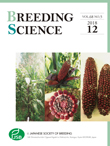68 巻, 5 号
選択された号の論文の17件中1~17を表示しています
- |<
- <
- 1
- >
- >|
Cover
-
2018 年 68 巻 5 号 p. cover
発行日: 2018年
公開日: 2018/12/29
PDF形式でダウンロード (16572K)
Research Papers
-
2018 年 68 巻 5 号 p. 499-507
発行日: 2018年
公開日: 2018/12/29
[早期公開] 公開日: 2018/11/16PDF形式でダウンロード (881K) HTML形式で全画面表示 -
2018 年 68 巻 5 号 p. 508-515
発行日: 2018年
公開日: 2018/12/29
[早期公開] 公開日: 2018/11/16PDF形式でダウンロード (3198K) HTML形式で全画面表示 -
2018 年 68 巻 5 号 p. 516-523
発行日: 2018年
公開日: 2018/12/29
[早期公開] 公開日: 2018/11/16PDF形式でダウンロード (2216K) HTML形式で全画面表示 -
2018 年 68 巻 5 号 p. 524-535
発行日: 2018年
公開日: 2018/12/29
[早期公開] 公開日: 2018/11/17PDF形式でダウンロード (3207K) HTML形式で全画面表示 -
2018 年 68 巻 5 号 p. 536-544
発行日: 2018年
公開日: 2018/12/29
[早期公開] 公開日: 2018/11/23PDF形式でダウンロード (4598K) HTML形式で全画面表示 -
2018 年 68 巻 5 号 p. 545-553
発行日: 2018年
公開日: 2018/12/29
[早期公開] 公開日: 2018/12/01PDF形式でダウンロード (2626K) HTML形式で全画面表示 -
2018 年 68 巻 5 号 p. 554-560
発行日: 2018年
公開日: 2018/12/29
[早期公開] 公開日: 2018/11/23PDF形式でダウンロード (2063K) HTML形式で全画面表示 -
2018 年 68 巻 5 号 p. 561-570
発行日: 2018年
公開日: 2018/12/29
[早期公開] 公開日: 2018/11/28PDF形式でダウンロード (2597K) HTML形式で全画面表示 -
2018 年 68 巻 5 号 p. 571-581
発行日: 2018年
公開日: 2018/12/29
[早期公開] 公開日: 2018/11/17PDF形式でダウンロード (5008K) HTML形式で全画面表示 -
2018 年 68 巻 5 号 p. 582-586
発行日: 2018年
公開日: 2018/12/29
[早期公開] 公開日: 2018/11/28PDF形式でダウンロード (920K) HTML形式で全画面表示 -
2018 年 68 巻 5 号 p. 587-595
発行日: 2018年
公開日: 2018/12/29
[早期公開] 公開日: 2018/11/28PDF形式でダウンロード (2129K) HTML形式で全画面表示 -
2018 年 68 巻 5 号 p. 596-605
発行日: 2018年
公開日: 2018/12/29
[早期公開] 公開日: 2018/11/21PDF形式でダウンロード (1956K) HTML形式で全画面表示 -
2018 年 68 巻 5 号 p. 606-613
発行日: 2018年
公開日: 2018/12/29
[早期公開] 公開日: 2018/11/16PDF形式でダウンロード (3794K) HTML形式で全画面表示 -
2018 年 68 巻 5 号 p. 614-621
発行日: 2018年
公開日: 2018/12/29
[早期公開] 公開日: 2018/11/28PDF形式でダウンロード (1283K) HTML形式で全画面表示 -
2018 年 68 巻 5 号 p. 622-628
発行日: 2018年
公開日: 2018/12/29
[早期公開] 公開日: 2018/11/23PDF形式でダウンロード (1651K) HTML形式で全画面表示
Note
-
2018 年 68 巻 5 号 p. 629-638
発行日: 2018年
公開日: 2018/12/29
[早期公開] 公開日: 2018/12/06PDF形式でダウンロード (1813K) HTML形式で全画面表示
- |<
- <
- 1
- >
- >|

